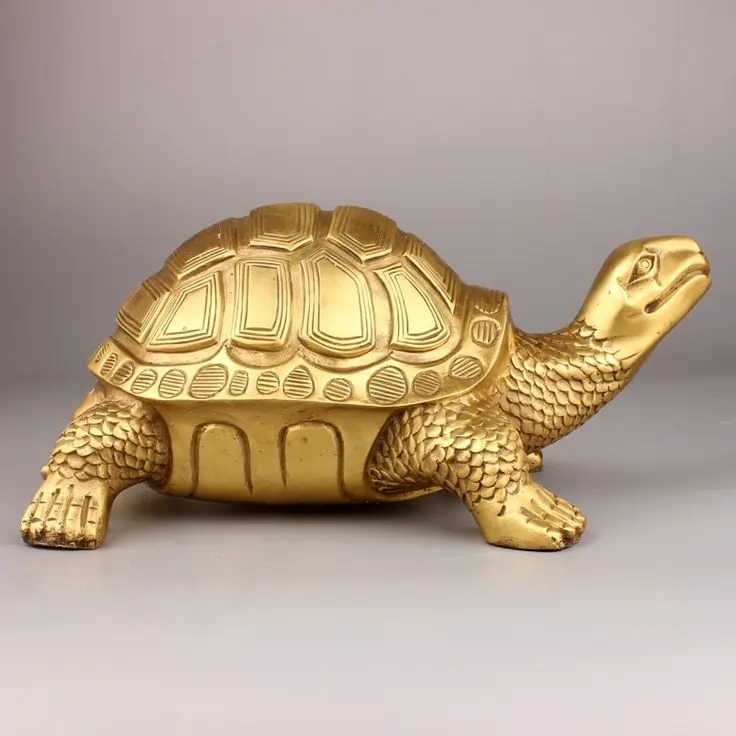Introduction:
Unlock your home’s hidden potential with the ancient wisdom of the Feng Shui Turtle and the Lucky Tortoise. Discover how the direction in which your tortoise faces can transform your living space into a source of prosperity and positive energy.
In Feng Shui and Vastu, the Lucky Tortoise is revered as a powerful symbol of protection, longevity, and wealth. Understanding the importance of the Lucky Tortoise’s face direction is crucial for harnessing these benefits. Whether you are a seasoned practitioner or a curious starter, this guide will provide valuable insights into the correct placement and orientation of your Feng Shui Turtle. By following these well-researched tips, you can enhance the positive energy flow in your home, creating a harmonious and prosperous environment.
What is a Feng Shui Turtle?
A Fengshui turtle, sometimes a lucky or wealthy turtle, is a renowned symbol in Fengshui and is known for its positive energy and symbolism. It is described as having a baby turtle on its back and a coin in its mouth, representing longevity, wealth, and prosperity.

Place the feng shui turtle in the northwest direction of the house or office to increase career opportunities and attract wealth. The turtle represents a lifetime of wisdom and steadiness.
Ideal Placement of the Feng Shui Turtle:
● Living room: It is advisable to place the feng shui turtle in the north or eastern direction of the living room. This position is supposed to increase career growth and attract positive energies into the house. Keep the turtle near the surface of the water. It states that a fish taking a small indoor fountain can increase its benefits, and a sweater represents its wealth.
● Bedroom: Place the turtle at the foot of the bed to represent protection and support. It can assist in increasing stability and steadiness in personal relationships. Make sure that the place is free from clutter.
● Office: Position the feng shui turtle in the north or northwest corner of the office to increase career growth and stability for professional development.
Also Read: Best Direction for Puja Room to Boost Positive Energy in Your Home
Common Mistakes to Avoid:
● Incorrect direction: Make sure the turtle faces positive places, especially north or east. Incorrect positioning may block the flow of positive vibes and affect the turtle’s benefits.
● Improper room placement: It is advised not to position the turtle in rooms that might not be effective, such as bathrooms and kitchens.
● Neglecting the turtle: Ensure that the turtle is positioned in clean surroundings and properly maintained.
Lucky Tortoise Face Direction:
The position in which the Lucky Tortoise faces is necessary in Vastu Shastra. Proper positioning ensures positive energy flow and impacts life factors, including health, wealth, and overall well-being. Not positioning the tortoise may disrupt the flow of vibes, negatively influencing the household.
The best directions of the Lucky Tortoise to attract prosperity and luck are
North Direction:
The north direction is related to career growth and financial prosperity. Positioning the Lucky tortoise facing north can draw in opportunities and increase steadiness in professional life. Placing the fengshui turtle on a flat surface is advised, especially on a shelf or a small living room or office table.
East Direction:
The eastern direction is considered favorable as it is related to the health and well-being of the family. A lucky tortoise that faces the east is believed to bring harmony, good health, and positive energies to the family members. Positioning the tortoise in the eastern part of the house, including the living and dining rooms, can positively impact the dynamics.
Also Read: Brahma Kamal Plant Vastu
Adjusting Placement Based on Room Function:
- Place the tortoise on the eastern or northern side to increase positive energy flow, family unity, and financial steadiness.
- The Feng Shui tortoise should be positioned in the bedroom in the southwest direction. This position represents steadiness and support in personal relationships.
- Position the tortoise facing north on the desk or a nearby shelf to increase career prospects and stabilize professional life.
Combining Feng Shui and Vastu Practices:
The ancient Chinese practice of Fengshui mainly uses chi flow to increase the peacefulness of the surrounding ambiance.
- Both feng shui and vastu increase the effects of direction and elements. Both encourage recommending direction for different activities and utilizing other aspects to balance energy.
- Ensure the main door is tidy, well-lit, and away from instructions so that a flow of positive chi can enter.
- They ensure that the furniture and the objects are positioned properly according to the room size.
Conclusion:
In conclusion, the Lucky Tortoise is significant in Feng Shui and Vastu, symbolizing longevity, protection, and prosperity. By understanding the importance of the Lucky Tortoise face direction, one can unlock the full potential of this ancient symbol and enhance the positive energy flow in their home.
Throughout this guide, we have explored the significance of the Feng Shui Turtle and the Lucky Tortoise face direction, delving into their historical context and practical applications. We have learned how the direction in which your tortoise faces can influence the energy in your living space, and we have discussed the best practices for placement according to Feng Shui and Vastu principles.
Following these tips can create a harmonious environment that promotes prosperity, health, and happiness. Embrace the wisdom of the Lucky Tortoise and change your home into a sanctuary of positive energy and abundance.
-
What is the significance of the lucky tortoise in Feng Shui and Vastu?
The tortoise symbolizes longevity, stability, and protection in Feng Shui and Vastu. It is a powerful symbol that brings positive energy, prosperity, and harmony to a home. The tortoise’s presence safeguards the household and promotes overall well-being.
-
Which direction should the tortoise face, according to Feng Shui?
According to Feng Shui, the tortoise should generally face north. This placement attracts career opportunities, support, and steady progress in life. Positioning the tortoise in the north direction helps enhance career prospects and brings stability to professional endeavors.
-
How should the tortoise be placed in the house as per Vastu Shastra?
In Vastu Shastra, the tortoise should be placed in the north or northeast direction. This placement ensures a balanced positive energy flow and supports prosperity and health. Additionally, placing the tortoise in a water-filled bowl or near a water feature can amplify its positive effects.
-
Can the tortoise be placed in the bedroom?
The tortoise can be placed in the bedroom but should be carefully positioned. To symbolize protection and support, put it at the foot of the bed, facing inward. Avoid placing it near the head of the bed or in cluttered areas to ensure a smooth flow of positive energy.
-
What are the common mistakes to avoid when placing a tortoise in the house?
Common mistakes include placing the tortoise in the wrong direction, such as facing south, which can disrupt positive energy flow. Avoid placing the tortoise in cluttered or dirty areas, which can negate its beneficial effects. Also, the space should be manageable with multiple Feng Shui or Vastu symbols, which can create confusion.
-
Are there any specific materials for tortoise figurines that are recommended in Feng Shui and Vastu?
In Feng Shui, tortoise figurines made of metal, crystal, or glass are preferred as they enhance the flow of chi. In Vastu, tortoises made from natural materials like metal or stone are considered auspicious. The material should be chosen based on the area of placement and the specific benefits desired.







2 thoughts on “Lucky Tortoise Face Direction: Feng Shui and Vastu tips”